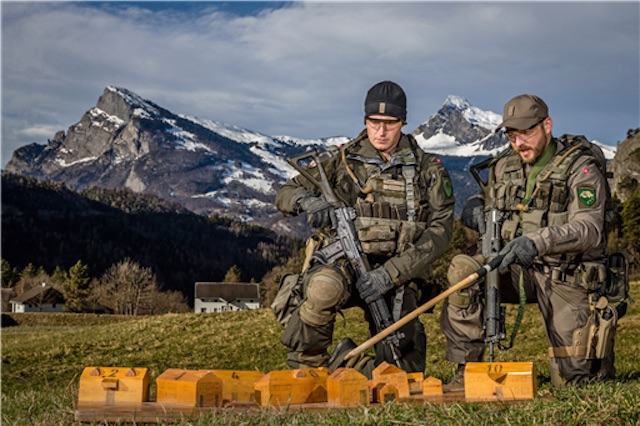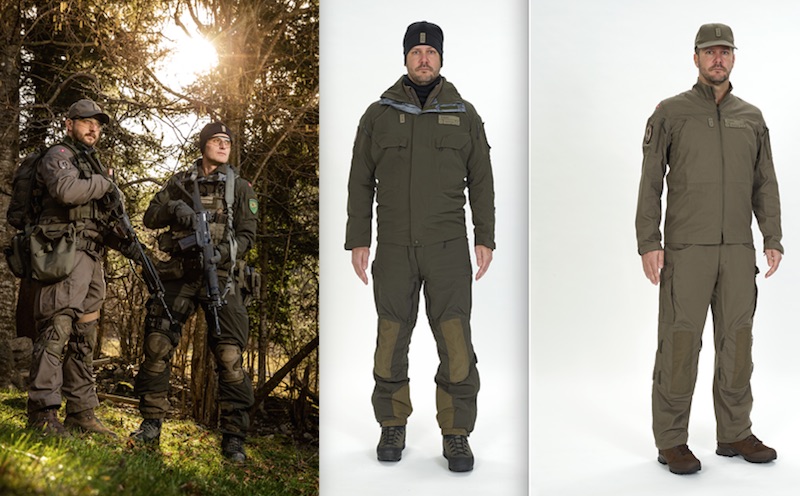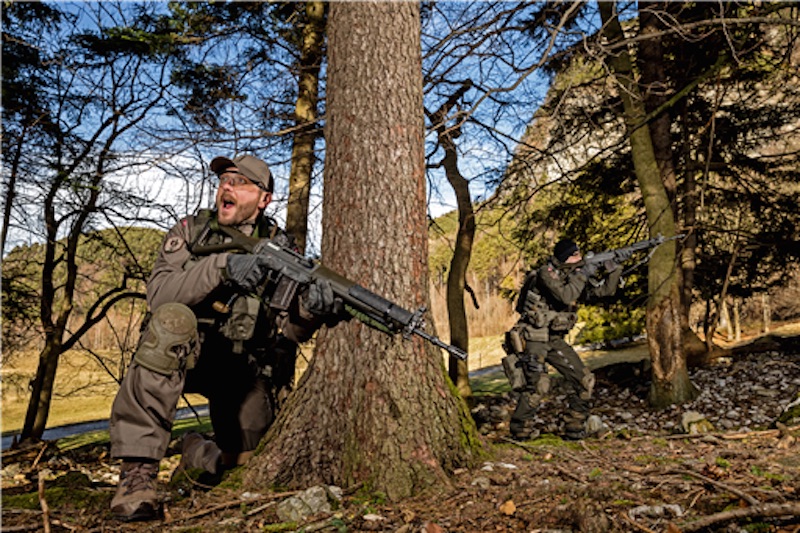Hol Dir den wöchentlichen SPARTANAT-Newsletter.
Dein Bonus: das gratis E-Book von SPARTANAT.

Neue Ausrüstung für die Schweiz: Modulares Bekleidungs- und Ausrüstungssystem (MBAS)
Jeder will sich weiterentwickeln, die Schweizer sind da keine Ausnahme. Aber sie sind flott.
Jeder will sich weiterentwickeln, die Schweizer sind da keine Ausnahme. Aber sie sind flott. 2016 wurde die „Weiterentwicklung der Armee“ als Programm beschlossen. Seit dem 1. Januar 2018 wird umgesetzt. Ab 2022 ersetzt das neue „Modulare Bekleidungs-und Ausrüstungssystem (MBAS)“ die vormalig genutzte „Kampfbekleidung 90/06“ – wir haben MBAS bereits HIER und HIER voriges Jahr auf SPARTANAT vorgestellt.
Nun gibt es aber die neue „Armeebotschaft 2018“. Die kommt ohne Botschaftsgebäude aus und ist eigentlich auch keine Nachricht von der Armee, wie der lustige Schweizer Name suggerieren könnte, sondern es handelt sich um den Antrag des Bundesrates um die Genehmigung des entsprechenden Budgets für Rüstungsvorhaben. Ein wesentlicher Teil davon ist das „Modulare Bekleidungs-und Ausrüstungssystem (MBAS)“. Und die Eidgenossen lassen sich das was kosten: 377 Millionen Schweizerfranken sollen für MBAS genehmigt werden. Das ist die Ausrüstung für 100.000 Armeeangehörige. 3.000 Franken gibt man pro Mann aus, die ballistischen Schutzplatten nehmen die Hälfte der Kosten.

Was man in den hier gezeigten Bildern noch in einer neutralen Farbe sieht, kommt final dann in diesem Tarnmuster.
Wir dokumentieren hier die Textstelle der Armeebotschaft 2018 zum Thema MBAS. Dazu gibt es die frischesten Bilder zur neuen Ausrüstung der Schweizer.
Armeebotschaft 2018 (Auszug)
Modulare Bekleidung und Ausrüstung Ausgangslage und Handlungsbedarf
Die gegenwärtig in der Nutzung stehende Kampfbekleidung 90/06 mit der dazugehörigen Grundtrageinheit wurde im Verlauf der 1990er-Jahre in der Armee eingeführt und prägt das Bild der Armeeangehörigen seit über fünfundzwanzig Jahren. Die verwendeten Materialien entsprechen dem damaligen technologischen Stand (z.B. bezüglich Atmungsaktivität und Witterungsschutz). Um den einsatzspezifischen, technologischen und logistischen Veränderungen Rechnung zu tragen, drängt sich die Einführung einer neuen Bekleidung und Ausrüstung auf. Zudem laufen die Nutzungs- und die Garantiezeit der Schutzweste 96 aus.

Es bleibt bei Zwiebelschale: Auch MBAS arbeitet mit verschiedenen Schichten, soll auch nicht alles ersetzen. Was gut ist, bleibt.
Bis zur Einführung der neuen modularen Bekleidung und Ausrüstung, die ab 2022 geplant ist, werden die Armeeangehörigen weiterhin mit der aktuellen Kampfbekleidung 90/06 ausgerüstet. Diese wird sowohl als Teil der persönlichen Ausrüstung als auch im Rahmen der Grundausrüstung (Korpsmaterial) in Schulen, in Wiederholungskursen und bei Einsätzen abgegeben. Um den Bedarf der kommenden Jahre zu decken, sind auch bei der aktuellen Kampfbekleidung Folgebeschaffungen nötig, die über den AEB-Kredit beantragt werden. Es ist nicht vorgesehen, diese Bekleidungs- und Ausrüstungsgegenstände unmittelbar nach der Einführung der neue Bekleidung und Ausrüstung zu liquidieren. Vielmehr sollen Komponenten der Kampfbekleidung 90/06 auch nach der Einführung der neuen modularen Bekleidung und Ausrüstung vorläufig weiterverwendet werden.
Neben der erforderlichen Folgebeschaffungen der aktuellen Kampfbekleidung 90/06 wird in der vorliegenden Armeebotschaft auch eine Nachbeschaffung von Schutzplatten für die Schutzweste 96 beantragt (vgl. Ziff. 2.7). Diese ist nötig, weil für einen erheblichen Teil der vorhandenen Schutzwesten keine Schutzplatten vorhanden sind, wodurch der Schutz der Armeeangehörigen in robusten Einsätzen nicht sichergestellt werden kann. Die zur Schliessung von Ausrüstungslücken nachbeschafften Schutzplatten werden sich im ballistischen Körperschutz der neuen Bekleidung und Ausrüstung weiterverwenden lassen.

Neue Kernelemente: Modularer Plattenträger, Trinksysteme, moderner Rucksack und entsprechende Textilien.
Beschreibung der beantragten Variante und Begründung
Die beantragte Bekleidung und Ausrüstung soll die Angehörigen der Armee bei ihrer Auftragserfüllung unterstützen und verfügt dazu über eine hohe Modularität, aller Komponenten, weshalb sie als „Modulares Bekleidungs- und Ausrüstungssystem“ (MBAS) bezeichnet wird. Die Beschaffung umfasst folgende Komponenten:
- – Kampfbekleidung: Tarnanzug, Wind-, Regen- und Kälteschutz;
- – Tragsysteme: Tragvorrichtungen, Rucksäcke und Taschensätze;
- – Ballistischer Körperschutz in zwei Ausführungen: eine Version mit reduzierter Schutzfläche für Gefechtseinsätze mit hoher physischer Belastung und zur Gewährleistung der Beweglichkeit sowie eine zweite Version mit dazugehörigem Kragen und Unterleibsschutz mit maximaler Schutzfläche für Bewachungseinsätze mit normaler physischer Belastung;
- – Trinksystem: Wasserbeutel, Trinkschläuche und verschiedene Adapter für PET-Flaschen. Das bewährte „Zwiebelschalenprinzip“ der Kampfbekleidung 90/06 soll mit der beantragten Beschaffung beibehalten werden. Das heisst, dass es der oder dem Armeeangehörigen weiterhin möglich sein soll, die eigene Bekleidung den Temperatur- und Witterungsverhältnissen anzupassen. Die einzelnen Taschen können einsatzspezifisch montiert und getragen werden (wahlweise an einer Tragvorrichtung, einem Rucksack, einem Plattenträger oder einer Schutzweste). Die neue Bekleidung und Ausrüstung ist in Bezug auf Ergonomie und Thermophysiologie besser als die aktuelle, was sich leistungssteigernd auswirkt. Sie ist auf ein Minimum an Volumen und Gewicht reduziert und modular aufgebaut. Dank den modular verwendbaren Bestandteilen wie Taschen und Schutzplatten können Bekleidung und Ausrüstung einsatzspezifisch ausgelegt werden. Wo dies sinnvoll ist, wird angestrebt, dass sich bereits eingeführte oder in Einführung stehende Ausrüstungsgegenstände in die neue modulare Bekleidung und Ausrüstung integrieren lassen.
Die neue Bekleidung und Ausrüstung wurde in einem Truppenversuch mit rund 350 Armeeangehörigen aus insgesamt 13 Lehrverbänden und Kompetenzzentren eingehend überprüft und die Truppentauglichkeit in der Praxis beurteilt. Dabei wurden alle Komponenten in Unifarben getestet. Mit der Einführung wird für einen grossen Teil der Komponenten ein neues Tarnmuster verwendet.
Mit dem beantragten Verpflichtungskredit können 100 000 Armeeangehörige ausgerüstet werden. Die neue Bekleidung und Ausrüstung wird rund 3000 Franken pro Person kosten, wobei rund die Hälfte auf den ballistischen Körperschutz entfällt.

Das Plattenträgersystem mit Chest Rig und Taschen. Eine sehr vielseitige Lösung in einer modularen Ausstattung.
Die neue Bekleidung und Ausrüstung wird der Truppe in Schulen und Kursen und bei Einsätzen als Korpsmaterial abgegeben. Für die Logistik wird eine Umlaufreserve ausgeschieden. Die Beschaffung wird im Jahr 2020 öffentlich ausgeschrieben. Die neue Bekleidung und Ausrüstung soll ab 2022 eingeführt werden. Sie soll mindestens 25 Jahre genutzt werden können.
Weitere geprüfte Varianten
Als Alternative zu einem Ersatz wurde eine Nutzungsdauerverlängerung der bestehenden Bekleidung und Ausrüstung geprüft. Eine solche Lösung wurde jedoch nach sorgfältiger Prüfung verworfen. Ein wesentlicher Grund ist, dass die heutige, bald dreissigjährige Bekleidung und Ausrüstung bei einer reinen Nutzungsdauerverlängerung nicht an die heutigen Bedürfnisse bezüglich Ergonomie und Witterungsschutz angepasst werden könnte. Ein weiterer Grund ist, dass nach Ablauf der Nutzungs- und Garantiezeit der Schutzweste 96 Bedarf für ein Nachfolgesystem besteht. Wie bei Waffensystemen wurden auch bei der Ausrüstung und der Bekleidung seit den frühen 1990er-Jahren bezüglich Funktionalität und Qualität Fortschritte erzielt. Zudem werden durch den Neuausrüstungs- und Retablierungsbedarf jährlich grössere Mengen der eingeführten Bekleidung und Ausrüstung beschafft. Eine Verlängerung der Nutzungsdauer bringt daher keine Einsparungen.

So kann das dann individualisiert ausschauen. Wobei wir schon erkennen, wie genau die Eidgenossen hingeschaut haben. Die Schweizer Armee hat sich internationale Anregungen bei diversen Herstellern geholt, und diese in eine Eigenkonstruktion einfließen lassen.
Ebenso wurde geprüft, die modulare Bekleidung und Ausrüstung mit einem späteren Rüstungsprogramm zu beantragen. Darauf wurde verzichtet, weil einerseits mit der WEA die vollständige Ausrüstung gefordert wurde. Der individuelle Schutz der Armeeangehörigen hat dabei eine hohe Priorität. Andererseits ist die Evaluation der neuen modularen Bekleidung und Ausrüstung weit fortgeschritten.
Risikobeurteilung
Die einzelnen Komponenten der neuen Bekleidung und Ausrüstung basieren grundsätzlich auf Lösungen, die dem heutigen technischen Stand marktüblicher Produkte entsprechen. Zur Risikominderung wurden Versuche durchgeführt. Diese bezogen sich insbesondere auf die notwendigen Anpassungen an die mitzuführenden Gegenstände der Armeeangehörigen, die Modularität, die Kombinierbarkeit der Subsysteme sowie deren Komponenten und die Logistikprozesse.
Das geistige Eigentum der Subsysteme gehört der armasuisse. Mit den öffentlichen Ausschreibungen kann daher lieferantenunabhängig und mit einer hohen Versorgungssicherheit beschafft werden.
ARMASUISSE im Internet: www.ar.admin.ch
SPARTANAT ist das Online-Magazin für Military News, Tactical Life, Gear & Reviews.
Schickt uns eure News: [email protected]
Werbung
Hol Dir den wöchentlichen SPARTANAT-Newsletter.
Dein Bonus: das gratis E-Book von SPARTANAT.




